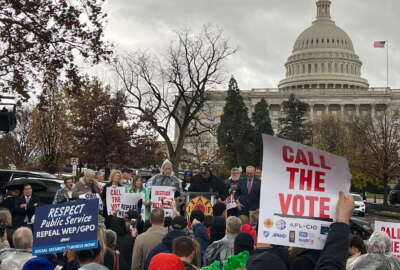Congress is really close to final repeal of Social Security limitations on government retirees
WEP and GPO have reduced Social Security benefits for thousands of state and local government employees and certain federal ones.
It’s so close that those in favor can practically taste it. The statutory ending of the windfall elimination provision and the government pension offset. WEP and GPO have reduced Social Security benefits for thousands of state and local government employees and certain federal ones. John Hatton, staff vice president of the National Active and Retired Federal Employees Association, joined the Federal Drive with Tom Temin for an update and other matters.
Interview transcript:
Tom Temin: And John, this is really just a matter of scheduling in a Senate floor vote at this point?
John Hatton: Well, it’s got to be scheduled and the votes got to pass. So there was a rally by the U.S. Capitol on Wednesday the 11th, and Schumer at that rally said he’s going to call for the vote. He just filed cloture on the motion to proceed to the vote. It’ll require 60 votes to get through those for the first stage of that voting to get to end debate on the motion, proceed and debate on the bill. So and then bill passage will be 50 votes. So that first vote, what we’re just looking for is everybody who said they supported the bill via co-sponsorship votes for it and it will pass. But that is an if. Not every single House member who said they were going to co-sponsor the bill voted for it at the end of the day. So we really need to make sure that every single person who said they’re going to support this bill via co-sponsorship goes to the floor and votes for it.
Tom Temin: Yeah, it sounds a little morbid to say, but in the case of the CSRS employees of the federal government, the old civil service retirement system beneficiaries for whom this is effective, it’s got to happen one of these days because they’re an aging set of people.
John Hatton: Yeah. And I hope one of these days is next week and the Senate votes on it and passes it. This is something we’ve been working on for 40 years. It’s been penalizing people simply because they’ve earned their government pension and then they earn separately through private sector work, their Social Security benefits. And so our members who are the CSRs retirees have never understood it. They have always been upset by it. They view it as theft, as do we, and that goes for the firefighters, police officers, the teachers, the municipal workers around the country who are impacted by this as well. So it’s been a long time coming. It’s been a frustrating process where again there’s large numbers of members of Congress who say they support the bill. But we’ve always been frustrated by their ability to get a vote. And we were able to use the discharge petition to force a vote in the House. And when it got to the floor, 327 members of the House voted for it and only 75 against. And with that pressure, put to bare with a lot of co-sponsors in the Senate, 49 Democratic co-sponsors, there was a huge push to get this on the floor of the Senate for a vote. And Sen. Schumer agreed to put it on the floor. And now we’ll see where people are honest about what they say they want to do when they co-sponsor a bill or not.
Tom Temin: And if this should somehow not happen this time around, the next Senate, of course, is Republican controlled. But given the Trump administration or given the fact that Donald Trump is somewhat of a maverick, you might say it’s not a certainty as it is with some other matters and some other policy issues, that he would be against the elimination of WEP and GPO. He just came out in favor last week of the longshoreman in their battle with the ship operators in these contract negotiations. I just use that as an example of that’s not what you might have expected.
John Hatton: Right. Yeah. No, they’re shifting political coalitions with Trump coming into office. And I think he’s had different coalition than certainly the George W. Bush coalition had. So there’s always an opportunity there. But Trump hasn’t campaigned on repeal of WEP and GPO. Biden did. He hasn’t put it in administration policies, but he did campaign promising that he supports that. So our hope, if it gets to his desk, that he signs it. I think we had a strong bipartisan vote in the House. So there’s an opportunity to get it through the House again. I think getting a vote in the Senate with Republican leadership would be more challenging than with Schumer, as there was 49 of the co-sponsors Democratic, where there’s not a majority of Senate Republicans that are co-sponsors.
Tom Temin: Right. And it’s hard to rebuild momentum when there’s that big a shift in the power structure for at least for a couple of years. And the new team has all these different priorities. And they may even say, ‘Yeah, I agree, it’s a good idea.’ But that doesn’t mean anything in terms of what’s on the actual schedule for Congress.
John Hatton: Yeah, I think this is our real, I don’t want to say it’s our only opportunity, but this is the best opportunity we’ve ever had and I think it’ll be a better opportunity we have in the next two years. And we just cannot let this pass by. I think it’s a testament to all that the grassroots advocates that NARFE has and other people have that have really driven this process and driven the support in Congress as well.
Tom Temin: We’re speaking with John Hatton, staff vice president of the National Active and Retired Federal Employees Association. And then, except for the widely quoted and still repeatedly quoted article or op-ed piece in the Wall Street Journal several weeks ago from Vivek Ramaswamy and Elon Musk about DOGE, the Department of Government Efficiency. And they did have some appearances on Capitol Hill, but there’s no real laid out 1600 bullet point plan for what they plan to do yet. But Schedule F seems to be really high on the agenda, especially with Russ Vought coming back into government.
John Hatton: Yeah, I think Schedule F will be issued via executive. In the last Trump administration, it was issued via executive order with directives to the agencies. I expect a similar executive order be issued within the first week of the administration and I would be surprised if it wasn’t. That, I think was clear prior to this whole DOGE being created. And that will be, I think, a threat that we’ll have to deal with right off the bat. I think since the election, with the whole DOGE effort, which is still kind of wrapping our heads around exactly what that’s going to mean, I think that presents additional threats. And while it’s not a very clear plan, I do think that Wall Street Journal op-ed laid out a process in how they intend to go about what they’re doing. I think there’s basically three priorities that they have. First is not necessarily target federal employees but target federal regulations. They seemed to indicate that they were going to embed small government conservatives within these regulatory agencies to do regulatory review. Exactly how they intend to rescind regulations is unclear. Do they reissue them and have Congress look at them via Congressional Review Act? I think Rand Paul mentioned something like that. Do they say these are unconstitutional based on the major question of doctrine? Do they even go through the notice and comment rulemaking? So I think how they go about trying to rescind regulations and drastically reduce the number of regulations in the federal government is unclear. But it’s clear that they want to do that. And I think it’s clear they’re going to try to do something there.
Tom Temin: I was going to say, that’s a good way that you’ve laid out the possibilities because regulations are like dandelions. Some people like them, some people don’t or they don’t like a particular one. I mean, that’s everyone likes their regulation that they want. But you can pluck out the yellow sort of by not enforcing it, but it’s still there. Or you can take it out by the root, which is legislative abolishment of that type of thing. Or there’s some hybrid way, stick that squirting poison dispenser on it. It could grow back but that would be reregulating through the rulemaking process. And that’s slow and painstaking.
John Hatton: Yeah. And one of the things that I believe they mentioned in the op-ed was that they would just stop enforcing regulations that they meant to rescind. So there might be an interim step and then they go about the more arduous process. And I think they’ll be legal challenges to a lot of those actions. The second step, though, is then I think, more targeted at the federal workforce, particularly though, well, it wasn’t explicit. I think it was implicit that they’re targeting the regulatory agency workforce and reducing the size of them. So they’re saying we’re not going to need these regulations and therefore we’re not going to need the employees to issue them and enforce them. And they foreshadowed a return to office policy aimed at having people quit so they don’t have to fire them later, potentially relocations with the same ends. And then if those don’t get to where they need to do, then reductions in force. And they said, ‘Oh, we’re so nice. We’re going to do voluntary severance agreements and early retirement buyouts.’ But I think the idea is that they drastically want to gut those regulatory agencies. And then the third part, which is the government efficiency part, not the regulatory part, but that’s what’s kind of the waste, fraud, abuse element. And I think our argument there is that is a good goal and you should be partners with the public servants in the federal workforce to do that. I mean, you have Elon Musk tweeting out GAO reports. It’s like, well, that’s great or IG reports is like, those are public employees. Those are federal employees saying this is what we want to do. So if all you want to do is implement GAO and IG recommendations, then go at it. I think a lot of the waste, fraud and abuse that exists within the federal government isn’t driven by public servants and the federal employees, and it’s driven by contracts that are not efficient. It’s driven by payments that shouldn’t be going to people that shouldn’t get them, for example, in Medicare or Medicaid. So those types of efforts, I hope there can be a shift in the public understanding of this and even maybe potentially in some of the administration that you need good public servants and federal employees to get at those ends.
Tom Temin: Right. They really have two questions. What should government do and what should it not do? That’s one question. But the other question is, once you decide what it does, do, are you going to make sure it does it right? And that doesn’t take money sometimes.
John Hatton: Yeah, I agree. I mean, if you want to modernize technology. That’s going to require money. And this idea that you can just fire a lot of the employees, the federal workforce. The size of it has gone down over the last 40, 50 years and particularly down as a percentage of the overall labor force. So the growth in government and spending has been on the contractor side of things where there’s 2 to 1 government contractors, the federal employees. And obviously entitlements like Social Security, Medicare and things like that. So this idea that there’s this large over massive federal workforce just is not borne by the facts.
Copyright © 2025 Federal News Network. All rights reserved. This website is not intended for users located within the European Economic Area.
Tom Temin is host of the Federal Drive and has been providing insight on federal technology and management issues for more than 30 years.
Follow @tteminWFED






